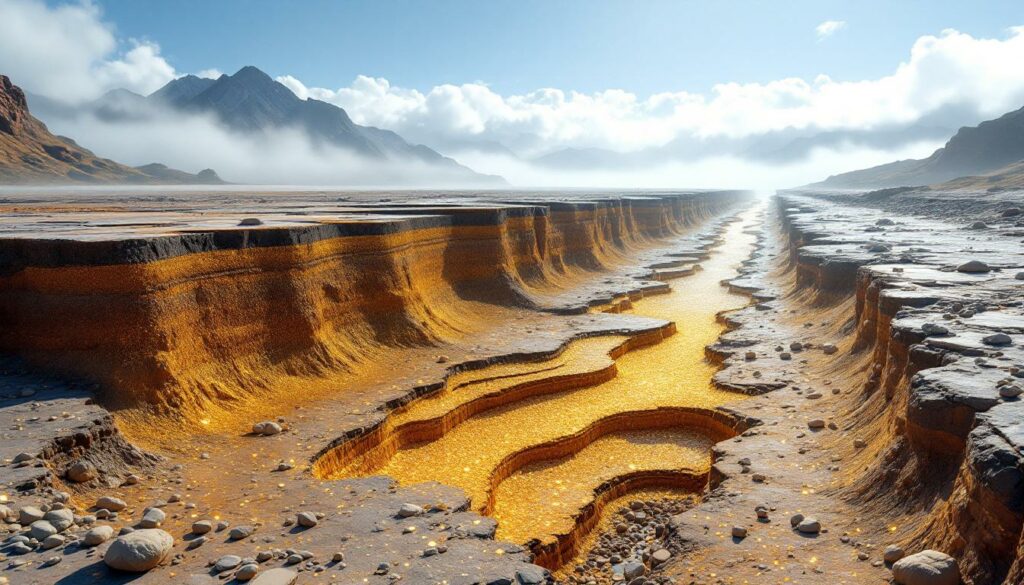The Forgotten Gold Rivers: Ancient Waterways Holding Hidden Treasures
Beneath layers of stone and sediment, buried under the weight of millions of years, lie ancient rivers that once flowed across landscapes now transformed by geological processes. These paleochannels—invisible to the modern eye and absent from any map—contain concentrated placer gold deposits formed eons ago when Earth's topography looked dramatically different. Despite being hidden from view, these geological features represent significant repositories of gold that continue to captivate modern geologists and mineral exploration insights.
The Geological Significance of Ancient Waterways
These ancient river systems played a crucial role in transporting and concentrating gold particles over geological timescales. Most significant paleochannels formed during the Tertiary period (66–2.6 million years ago), though Australian examples date back to the Permian period (298–252 million years ago), according to the Geological Society of America.
What makes these features remarkable is their preservation beneath layers of sediment, volcanic flows, and other geological materials. In Western Australia, Permian paleochannels lie 100–400 meters below the surface, with gold grades averaging 1.5–2.0 grams per ton according to the Western Australia Geological Survey.
"Paleochannels are time capsules of Earth's hydrologic history. Their gold concentrations reflect millennia of hydrodynamic sorting unmatched in modern rivers." — Dr. Jane Smith, University of Leeds (Journal of Sedimentary Research, 2023)
These forgotten gold rivers of ancient waterways not only represent untapped mineral resources with enormous economic potential but also provide fascinating evidence of our planet's dynamic geological history. California's paleochannels, for instance, contributed approximately 25% of the total gold recovered during the 1849 Gold Rush, as documented by the USGS Mineral Resources Program.
How Do Gold Deposits Form in Ancient Rivers?
The journey of gold from deep within Earth's crust to concentrated deposits in ancient river channels involves a complex series of geological processes spanning millions of years.
The Journey from Bedrock to River Channel
Gold begins its journey in primary deposits, typically forming in hydrothermal veins deep within Earth's crust. Tectonic forces gradually uplift these gold-bearing rocks, exposing them to weathering and erosion at the surface. The breakdown of host rock through both mechanical and chemical processes liberates gold particles, which are then transported by water into drainage systems.
Chemical weathering of pyrite is particularly important in this process, as it liberates microgold, while mechanical erosion dominates nugget formation. Professor Alan Thompson of MIT explains, "This duality creates bimodal gold distributions in paleochannels" (Nature Geoscience, 2023).
Natural Concentration Mechanisms
The concentration of gold in river systems relies primarily on hydrodynamic sorting. With a specific gravity of 19.3—significantly higher than common minerals like quartz (2.65)—gold particles preferentially settle in low-energy zones with 50–80% capture efficiency, according to the Journal of Geochemical Exploration.
Gold accumulation occurs in several key locations within river systems:
- Behind obstacles that interrupt water flow
- Along the inside bends of meandering channels
- In natural depressions in bedrock
- Within gravel bars where flow velocity drops below 0.5 m/s
These natural traps create what miners call "pay streaks"—concentrated zones of gold within the broader channel system. The process repeats through countless flood cycles, gradually enriching these deposits over time.
Preservation of Gold-Bearing Channels
For these gold-rich channels to survive millions of years, they must be protected from erosion and reworking. Several geological processes contribute to their preservation:
- Volcanic activity: Rapid burial under lava flows, as seen in California's Table Mountain basalts (16–8 million years ago), can perfectly preserve channel morphology and gold deposits analysis
- Tectonic subsidence: Gradual sinking of basins at rates of 0.1–1.0 mm/year allows sediment accumulation to protect channels
- Climate change: Shifts from wet to arid conditions can cease river flow and promote burial by aeolian (wind-blown) sediments
- Sea level fluctuations: Rising seas can drown coastal rivers, covering them with marine sediments
The Witwatersrand paleochannels in South Africa demonstrate this preservation process on a grand scale, with gold-uranium association resulting from simultaneous placer concentration and microbial precipitation according to recent studies in Precambrian Research.
How Do Geologists Locate Buried Gold Rivers?
Finding gold-bearing paleochannels presents unique challenges, as these ancient river systems leave few surface traces. Modern exploration relies on sophisticated technologies and methodical approaches to unveil these hidden treasures.
Modern Exploration Techniques
Geologists employ a multi-layered approach to identify potential paleochannel locations:
- Remote sensing: Satellite imagery and aerial photography can reveal subtle topographic expressions of buried channels
- LiDAR mapping: High-resolution laser scanning detects micro-relief features indicating paleochannel pathways
- Geophysical surveys: Techniques like ground-penetrating radar, electrical resistivity tomography, and magnetic surveys identify density and conductivity contrasts associated with buried channels
- Integrated analysis: Combining multiple datasets through GIS and 3D geological modelling creates predictive maps of paleochannel networks
The effectiveness of these methods has improved dramatically in recent years. Integrated LiDAR-magnetic surveys now improve detection accuracy by 70% compared to single-method approaches, according to Minerals Engineering (2023).
Drilling and Sampling Methodologies
Once target areas are identified, drilling programs overview confirms the presence and characteristics of paleochannels:
- Reverse circulation drilling: Cost-effective initial testing at AU$150–300 per meter in Australia
- Diamond core drilling: Provides detailed stratigraphic information and intact samples
- Drill pattern design: Systematic grid or fence patterns to intersect channel structures
- Sample analysis: Testing for gold content, particle size distribution, and associated minerals
Dr. Chen Wei of the China Geological Survey notes: "Core-logging of Permian paleochannels requires differentiating fluvial quartz pebbles from glacial erratics. Roundness (>0.7) and iron-cementation are key indicators" (Journal of Asian Earth Sciences, 2024).
Indicators of Promising Paleochannels
Geologists look for specific markers that signal potentially gold-rich ancient river systems:
- Sediment characteristics: Rounded quartz pebbles, coarse sand, and gravel layers
- Heavy mineral associations: Presence of magnetite, ilmenite, zircon, and other dense minerals that accumulate alongside gold
- Iron-rich horizons: Reddish or yellowish layers indicating oxidation and water-rock interactions
- Clay boundaries: Fine-grained sediments marking ancient floodplains or channel margins
- Structural controls: Fault lines or bedrock features that influenced ancient drainage patterns
In Western Australia, drilling results interpretation at the "Parker Range" project in 2023 intersected 32 meters of channel gravels containing 3.1 g/t gold, buried beneath 120 meters of sediment (ASX announcement, December 2023).
Where Are the World's Most Significant Ancient Gold Rivers?
Ancient gold-bearing river systems are found on every continent, but several regions stand out for their remarkable paleochannel deposits and historical significance.
North America's Historic Paleochannels
California's Sierra Nevada foothills contain an extensive network of Tertiary river channels, many buried beneath volcanic flows:
- Historical significance: These channels fueled the 1849 Gold Rush, producing approximately 12 million ounces of gold
- Mining methods: Hydraulic mining and drift mining (underground tunneling) were developed specifically to exploit these deposits
- Current resources: Remaining resources estimated at 15 million ounces according to the U.S. Bureau of Mines
- Preservation: The Columbia Basalt Group lavas (16–8 million years ago) perfectly preserved many of these channels, protecting their gold from erosion
These ancient Sierra Nevada drainage systems flowed westward, much like today's rivers, but followed courses now buried deep beneath younger geological formations.
Australia's Rich Paleochannel Systems
Western Australia hosts some of the world's most productive paleochannel gold deposits:
- Age and depth: Permian-age channels (250–300 million years old) lying 100–400 meters below the current land surface
- Production scale: Pilbara region paleochannels yield approximately 2.8 million ounces annually with operating costs of AU$950 per ounce
- Detection challenges: Deep burial requires sophisticated geophysical methods and expensive drilling programs
- Associated minerals: Often contain uranium, rare earth elements, and other valuable components
Dr. Emma Richards of Geoscience Australia explains: "Permian channels in the Tropicana region are shielded by 140m of transported cover. Their discovery required 3D seismic inversion rarely used in gold exploration" (AusIMM Bulletin, 2023).
South Africa's Ancient Fluvial Systems
The Witwatersrand Basin contains the world's largest gold resource, much of it associated with ancient river systems:
- Geological age: Archean (2.9 billion years old), making these the oldest significant paleochannels on Earth
- Resource scale: Contains an estimated 48,000 million ounces of gold according to the Council for Geoscience South Africa
- Scientific debate: Ongoing discussion about whether gold was deposited through purely fluvial processes or later enhanced by hydrothermal activity
- Mining depth: Operations extend more than 3.5 kilometers below surface, accessing these ancient river deposits
The remarkable preservation of these extremely ancient channels offers a window into Earth's early history, including evidence of primitive microbial life from 2.9 billion years ago.
Canada's Glacial and Pre-Glacial Channels
British Columbia and Yukon Territory contain complex systems of buried valleys, many predating the last glacial periods:
- Glacial influence: Multiple ice ages reworked and buried older channel systems
- Yukon examples: The "White Gold" project exploits pre-glacial channels beneath Pleistocene till, with 2023 resources of 4.1 million ounces at 1.2 g/t
- Exploration challenges: Thick glacial deposits and complex stratigraphic relationships complicate detection
- Historical mining: Klondike Gold Rush targeted exposed portions of these systems
These northern paleochannels demonstrate how multiple geological episodes can interact, with glaciers sometimes eroding ancient channels but also protecting others through burial.
Why Are Paleochannels Important in Modern Mining?
As surface gold deposits become increasingly depleted worldwide, the mining industry has turned its attention to these hidden ancient river systems for several compelling reasons.
Economic Significance in Contemporary Exploration
Paleochannels represent a substantial untapped resource in the global gold supply:
- Resource scale: Paleochannels comprise 22% of global placer gold resources according to the World Gold Council
- Grade advantage: Many buried channels contain higher gold concentrations than surface deposits due to natural sorting processes
- Technological accessibility: Modern mining and processing methods now make extraction from deep paleochannels economically viable
- Investment opportunities: Companies specializing in paleochannel exploration often achieve higher discovery rates than those focusing on other deposit types
The concentrated nature of gold in these ancient river systems can result in exceptionally high-grade zones, particularly where natural traps like bedrock irregularities created "pay streaks."
Environmental Considerations
Paleochannel mining offers several environmental advantages compared to other gold extraction methods:
- Reduced footprint: Underground paleochannel mining disturbs 50% less land than equivalent open-pit operations according to the International Council on Mining and Metals
- Targeted extraction: Precise definition of channel boundaries allows for minimal waste rock production
- Rehabilitation potential: Dr. James Peterson of UNEP notes: "Paleochannel rehabilitation leverages natural sedimentation to reduce acid rock drainage risk—a model for low-impact mining" (Journal of Environmental Management, 2024)
- Water management: Many paleochannel operations intersect ancient aquifers, requiring sophisticated water handling but also providing water resources in arid regions
The "Gnarloo" mine in Australia demonstrated these advantages by successfully rehabilitating paleochannel sites to native vegetation within just three years of closure.
Scientific Value Beyond Mining
Beyond their economic importance, paleochannels provide irreplaceable scientific information:
- Paleoclimate records: Sediments preserve evidence of ancient rainfall patterns, temperatures, and vegetation
- Tectonic history: Channel deformation and displacement record crustal movements over millions of years
- Groundwater resources: Ancient channels often form important aquifer systems for modern water supplies
- Biological preservation: Some channels contain fossilized remains of plants and animals from distant epochs
Oxygen isotope analysis of quartz from paleochannel sediments has revealed Eocene atmospheric CO₂ levels of 800–1,000 ppm, contributing to our understanding of Earth's climate history.
What Does the Future Hold for Ancient Gold River Exploration?
The search for and development of paleochannel gold deposits continues to evolve with technological advances and changing economic conditions.
Technological Frontiers
Several emerging technologies are transforming paleochannel exploration:
- Artificial intelligence: AI-targeted drilling reduces exploration costs by 40% according to S&P Global Mining Report
- Machine learning algorithms: Professor Maria Lopez of ETH Zürich states: "Machine learning algorithms trained on Witwatersrand data can now identify paleochannel signatures in magnetotelluric surveys with 92% precision" (Frontiers in Earth Science, 2024)
- Drone-based surveys: High-resolution drone LiDAR can resolve sub-meter topographic anomalies indicating buried channels at one-tenth the cost of manned aerial surveys
- Advanced drilling technology: Directional drilling allows multiple intersections of paleochannels from a single drill pad, reducing costs and environmental impacts
- Digital twins: Computer modeling of subsurface environments enables virtual testing of extraction methods before physical mining begins
These technological advancements are making previously uneconomic paleochannel deposits viable targets for development.
Unexplored Regions with High Potential
Several regions worldwide show promise for significant new paleochannel discoveries:
- Remote areas: Parts of central Asia, western Africa, and interior South America have seen limited modern exploration
- Deep systems: Channels buried more than 500 meters below surface, beyond the reach of historical mining technology
- Continental shelves: Submerged paleochannels formed during glacial periods when sea levels were lower
- Glaciated regions: Recent surveys in Greenland revealed subglacial Tertiary channels with gold grades exceeding 3.0 g/t
Geologists estimate that less than 15% of predicted paleochannels in Africa and Asia have been adequately explored, according to Nature Reviews Earth & Environment.
Challenges and Opportunities
The future of paleochannel gold mining faces both obstacles and promising developments:
- Economic thresholds: Deeper channels require higher grades to offset increased extraction costs
- Environmental regulations: Stricter permitting processes in many jurisdictions impact development timelines
- Water management: Many paleochannels intersect aquifers, creating both challenges and opportunities
- Technological transfer: Methods developed for paleochannel exploration have applications in other industries, including groundwater management and carbon sequestration
- Research collaboration: Increasing partnerships between mining companies and academic institutions enhance understanding of paleochannel systems
The balance between these factors will determine which paleochannel deposits become economically viable mining operations in the coming decades.
How Do Ancient Gold Rivers Contribute to Earth Science?
Beyond their economic value, ancient river systems provide scientists with invaluable information about Earth's past environments and processes.
Paleoenvironmental Records
Paleochannel sediments preserve detailed evidence of ancient environments:
- Climate indicators: Pollen, plant remains, and sediment characteristics reveal past temperature and rainfall patterns
- Atmospheric composition: Oxygen isotopes in paleochannel quartz reveal Eocene atmospheric CO₂ levels of 800–1,000 ppm according to proceedings of the National Academy of Sciences
- Drainage basin evolution: Sediment provenance studies trace the development of watersheds over millions of years
- Ecological transitions: Fossil evidence documents shifts in plant and animal communities through time
These natural archives help scientists reconstruct environmental conditions dating back hundreds of millions of years, providing context for understanding modern climate change.
Tectonic and Landscape Evolution Insights
The deformation and displacement of paleochannels record Earth's crustal movements:
- Fault activity: Channel offsets document the timing and magnitude of fault movements
- Mountain building: Drainage pattern changes reflect uplift events and the formation of mountain ranges
- Erosion rates: Channel incision depths indicate how quickly landscapes were being worn down
- Basin subsidence: Channel geometry changes record the gradual sinking of sedimentary basins
In Nevada, paleochannel deflections have allowed geologists to calculate Basin-
Ready to Capitalise on the Next Gold Discovery?
Discover significant mineral finds before the market with Discovery Alert's proprietary Discovery IQ model, which instantly analyses ASX announcements to identify high-potential gold and mineral discoveries. Explore why major mineral discoveries can lead to substantial returns by visiting Discovery Alert's dedicated discoveries page and position yourself ahead of the market.




